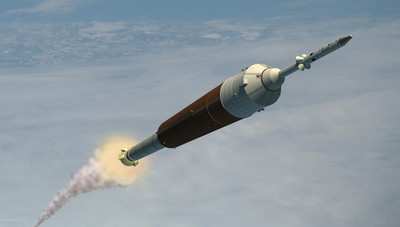Orbital Sciences To Supply Emergency Boosters
NASA has entered into an agreement with the US Air Force to
support abort flight test requirements for the Orion Project.
Aero-News learned Monday the Air Force has contracted with Orbital
Sciences Corp. of Chandler, AZ to provide launch services for the
flight tests.

The agreement with the Air Force's Space Development and Test
Wing at Kirtland Air Force Base, NM provides for abort test
boosters that will serve as launch vehicles for Orion ascent abort
flight tests that are set to occur from 2009 through 2011 at the
White Sands Missile Range in New Mexico. The first abort test is
scheduled for 2008, but will not require a functional booster.
The tests will support certification of the Orion crew
exploration vehicle's launch abort system. The system includes a
small escape rocket designed to ensure the safety of the crew in
the event of a launch vehicle malfunction while on the launch pad
or during ascent to orbit. A total of six tests are planned,
pending environmental assessments. Two will simulate an abort from
the launch pad and will not require a booster. The rest will use
abort test boosters and simulate aborts at three stressing
conditions along the Ares launch vehicle trajectory.
The Orion Project Office, based at NASA's Johnson Space Center
in Houston, designated Dryden Flight Research Center at Edwards Air
Force Base, CA as the lead NASA center for abort flight test
integration and operations, including procurement of the boosters.
The project is developing the Orion spacecraft as part of an effort
by NASA's Constellation Program to return humans to the moon and
prepare for future voyages to Mars and other destinations in our
solar system.
 Through a competitive procurement, the Air Force has awarded a
task order for two abort test boosters with options for two others
under the existing Sounding Rockets Program 2. This
indefinite-delivery, indefinite-quantity contract task order is
valued between $35 million and $57 million. The four Sounding
Rockets Program 2 contractors, including the winner, Orbital
Sciences of Dulles, VA were allowed to compete for the job of
providing booster integration and launch support services. The Air
Force has conducted 16 launches in the past 11 years under the
Sounding Rockets Program.
Through a competitive procurement, the Air Force has awarded a
task order for two abort test boosters with options for two others
under the existing Sounding Rockets Program 2. This
indefinite-delivery, indefinite-quantity contract task order is
valued between $35 million and $57 million. The four Sounding
Rockets Program 2 contractors, including the winner, Orbital
Sciences of Dulles, VA were allowed to compete for the job of
providing booster integration and launch support services. The Air
Force has conducted 16 launches in the past 11 years under the
Sounding Rockets Program.
The agreement for abort flight test support benefits both NASA
and the Air Force. By making use of the experienced Air Force and
contractor team, NASA reduces development risk associated with
design and development of a new and unique launch vehicle for these
tests. NASA also achieves financial savings while meeting an
aggressive Orion test schedule. The Air Force benefits through
reduced risk associated with future Air Force small launches,
increased opportunity for service personnel to gain expertise, and
a greater chance to share technologies.
The 3rd Space Test Squadron, a unit of the Air Force's Space
Development and Test Wing, will manage abort test booster launch
support services and integration of decommissioned
Peacekeeper-class intercontinental ballistic missile assets. On a
cost reimbursable basis, the squadron will provide integration
support, project management support and related services.
The squadron regularly uses decommissioned Minuteman II and
Peacekeeper rocket motors for government research and development
of space launch and missile defense test target vehicles.
 NTSB Final Report: Douglas A-4K
NTSB Final Report: Douglas A-4K ANN FAQ: Q&A 101
ANN FAQ: Q&A 101 Classic Aero-TV: PBY Catalina--From Wartime to Double Sunrise to the Long Sunset
Classic Aero-TV: PBY Catalina--From Wartime to Double Sunrise to the Long Sunset ANN's Daily Aero-Term (07.01.25): Advanced Air Mobility (AAM)
ANN's Daily Aero-Term (07.01.25): Advanced Air Mobility (AAM) ANN's Daily Aero-Linx (07.01.25)
ANN's Daily Aero-Linx (07.01.25)




